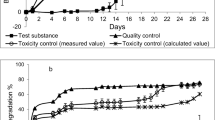Abstract
The toxicity and biodegradability of the main hydrolysis products of chemical warfare agents were investigated under methanogenic conditions. Among the tested substances, only MPhA does not have any toxic effect with regard to the aceticlastic methanogenic activity. The toxicity of other compounds varied between moderate (TDG, mercaptoethanol) to strong (ethanolamine, diisobutyl ester of MPhA). Biodegradability tests showed that all the products of chemical detoxification of mustard gas (ethanolamine, ethylene glycol, TDG, mercaptoethanol) can be biomineralized under methanogenic conditions. On the contrary, phosphorus-containing compounds from the chemical detoxification of nerve warfare agents (Sarin, Soman, Vx-gases) are quite persistent under these conditions.
Similar content being viewed by others
References
Smith, K. J., Hurst, C. G., Moeller, R. B., Skelton, H. G., and Sidell, F. R. (1995), J. Am. Acad. Dermatol. 32(5), 765–776.
Saunders, B. C. (1957), Some Aspects of the Chemistry and Toxic Action of Organic Compounds Containing Phosphorous and Fluorine, Cambridge University Press, New York.
Harvey, S., Defrank, J. J., Kamely, D., Valdes, J. J., Chakrabarty, A. M., Kamley, D., and Kornguth, S. E. (1991), Proceedings of US-Israel Research Conference on Advances in Applied Biotechnology, Kamley, D. and Chakrabarty, A. M., eds., June 24–30 1990, Haifa, Israel.
Varfolomeev, S. D., Kurochkin, I. N., Rainina, E. I., Kholstov, V. I., Zavyalova, N. V., and Wild, J. R. (1995), Rossiiskyi Khimicheskii Zhurnal 39(4), 20–24.
Boronin, A. N., Sakharovskii, V. G., Starovoitov, I. I., Zyakun, A. M., Shvetsov, V. N., Morozova, K. M., Nechaev, I. A., Tugushov, V. I., Kuz’min, N. P., and Kochergin, A. I. (1996), Prikladnaya Biokhimiya Mikrobiologiya 32(1), 61–68.
Sines, B. J., Teather, E. W., Harvey, S. P., and Weigand, W. A. (1994), Appl. Biochem. Biotechnol. 45/46, 881–895.
Pham, M. Q. K., Harvey, S. P., Weigand, W. A., and Bentley, W. E. (1996), Appl. Biochem. Biotechnol. 57/58, 779–789.
Dumora, C., Lacoste, A., and Cassaigne, A. (1983), Eur. J. Biochem. 133, 119–125.
Lee, K. S., Metcalf, W. W., and Wanner, B. L. (1992), J. Bacteriol. 174, 2501–2510.
Wanner, B. L. (1994), Biodegradation 5, 175–184.
Kertesz, M. A., Elgorriaga, A., and Amrhein, N. (1991), Biodegradation 2, 53–59.
Hidaka, T., Hidaka, M., Uozumi, T., and Seto, H. (1992), Mol. Gen. Genetics 233, 476–478.
Dumora, C., Lacoste, A., and Cassaigne, A. (1989), Biochim. Biophys. Acta 997, 193–198.
Wackett, L. P., Wanner, B. L., Venditti, C. P., and Walsh, C. T. (1987), J. Bacteriol. 169, 1753–1756.
McMullan, G. and Quinn, J. P. (1994), J. Bacteriol. 176, 320–324.
Kalyuzhnyi, S., Fedorovich, V., and Nozhevnikova, A. (1998), Bioresour. Technol. 65, 221–225.
American Public Health Association. (1985), Standard Methods for the Examination of Water and Wastewater, 16th ed., American Public Health Association, Washington, DC.
Rabinovich, V. L. and Havin, Z. Ya. (1977), Short Chemical Handbook, Khimiya Press, Moscow.
Beilstein’s Handbuch der Organischen Chemie (Fourth supplement), vol. 1, p. 2428.
Beilstein’s Handbuch der Organischen Chemie (Fourth supplement), vol. 4, pp. 3498 and 3502.
Henry, M. P., B. A. Donlon, P. N. Lens, and E. E. Colleran, (1996), J. Chem. Technol. Biotechnol. 66(3), 251–264.
Stewart, J. M., Bhattacharya, S. K., Madura, R. L., Mason, S. H., and Schonberg, J. C. (1995), Water Res. 12, 2730–2738.
Donlon, B. A., Razo-Flores, E., Field, J. A., and Lettinga, G. (1995), Appl. Environ. Microbiol. 61(11), 3889–3893.
Razo-Flores, E. (1997), PhD thesis, Wageningen Agriculture University, Netherlands.
Author information
Authors and Affiliations
Corresponding author
Rights and permissions
About this article
Cite this article
Sklyar, V.I., Mosolova, T.P., Kucherenko, I.A. et al. Anaerobic toxicity and biodegradability of hydrolysis products of chemical warfare agents. Appl Biochem Biotechnol 81, 107–117 (1999). https://doi.org/10.1385/ABAB:81:2:107
Received:
Revised:
Accepted:
Issue Date:
DOI: https://doi.org/10.1385/ABAB:81:2:107




